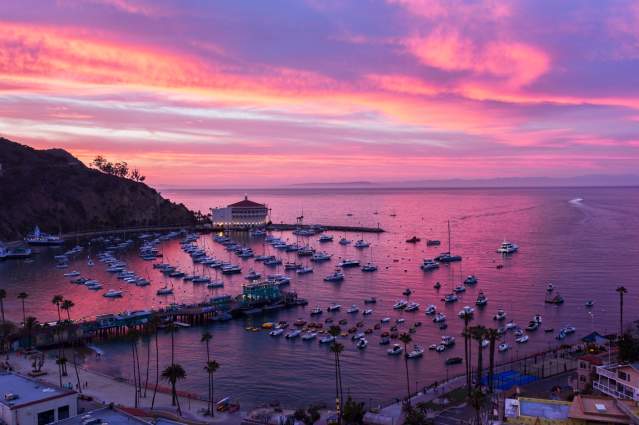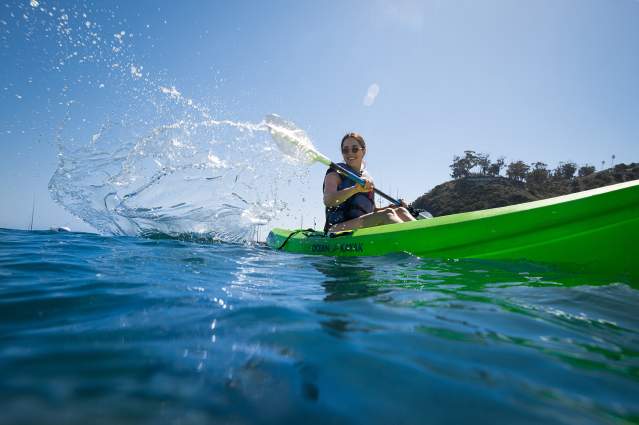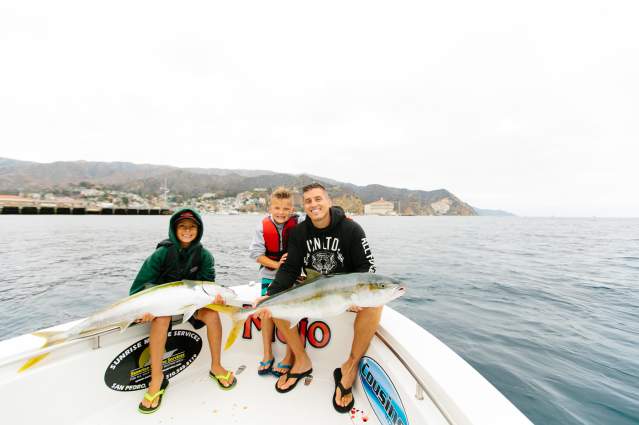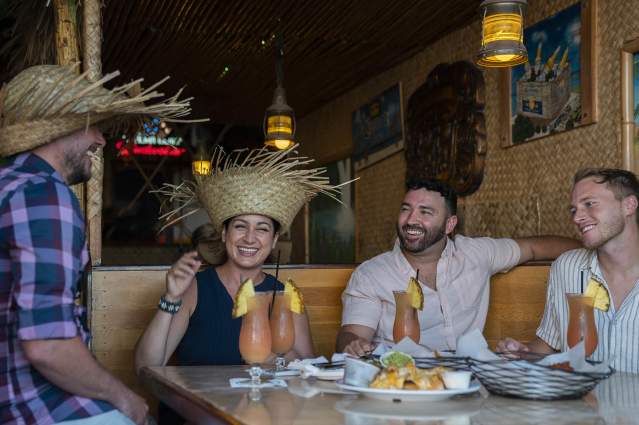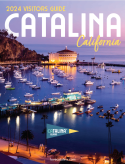Early Catalina Island History
Native Americans on Catalina Island
People have been living on Santa Catalina Island for at least 8,000 years. Archaeologists excavating on a limited scale at Little Harbor, on the seaward side of the Island, have found evidence of increasingly complex material cultures. These early groups of peoples exploited the rich resources of the sea–from abalone and other mollusks, to small and large fish, and marine mammals such as sea lions.
The semi-arid island offered limited plant resources, so the Islanders traded sea products and, in later years, steatite for their other needs. The Islanders made the 20-mile voyage to the mainland (and to the other Channel Islands) in well-crafted plank canoes. Steatite (an easily carvable rock that does not crack when put in the fire) from Santa Catalina has been found in both mainland and Island sites throughout southern California.
Over the millennia, as peoples migrated through California, different groups of Native Americans would have made their homes on the Island. For several thousand years before European contact, the Los Angeles basin and the Southern Channel Islands (Santa Catalina, San Clemente, and San Nicholas) appear to have been inhabited by peoples of linguistic affinity–the Takic branch of the Uto-Aztecan language family.
At the time of first European contact, it is thought that the people living on Santa Catalina Island called their island Pimu and themselves Pimungans (or Pimuvit). They were excellent seamen and paddled their plank canoes skillfully across the sometimes treacherous channel to trade. After Spanish colonization, their apparently flourishing population declined drastically with the introduction of new diseases to which they had little immunity. As the mission system altered the economic landscape of southern California, the Pimungans’ trade and social networks were disrupted.
In the aftermath of this enormous culture shock, their society could no longer sustain itself. By the mid-1820s, the few Pimungans left had migrated or were moved to the mainland. The Pimungans, along with other Native American groups that were in the sphere of influence of Mission San Gabriel, came to be referred to in the European community as Gabrielinos. There are people living in the southern California area today who have Gabrielinos among their ancestors.
Spanish Explorers Arrive on Catalina
The Pimungans of Santa Catalina Island paddled out to greet the Spanish galleon that bore the explorer Juan Rodriguez Cabrillo to their shores on October 7, 1542. Just 50 years after Columbus first sailed into the Western Hemisphere, the Viceroy of New Spain (Mexico) had authorized an expedition up the coast of California in search of a passage to the Far East. The Pimungans were invited aboard ship and gifts were exchanged. It is not known which cove the Spanish ship anchored in. Cabrillo, of course, claimed the Island for the King of Spain. The visit was duly noted in the ship’s log and the Island was given the name San Salvador, after Cabrillo’s ship. Cabrillo sailed on up the coast after about half a day.
Except for the possible occasional sighting of the yearly Manila Galleon sailing down the coast on its return to New Spain from the Philippines, the Pimungans were left in peace until 1602. On November 24, the eve of St. Catherine’s Day, the ship of the second Spanish explorer, Sebastian Viscaino, sighted the Island. Viscaino renamed it Santa Catalina in honor of Saint Catherine. His party stayed a day or two longer than Cabrillo and explored a bit on foot before sailing on. An Augustinian friar with the expedition said the first Catholic Mass on Santa Catalina. Relations with the Pimungans were amicable, although the Islanders became distressed when the sailors shot some Ravens, which held a special place in their world.
Otter Hunters on Catalina
The Pimungans began to feel the Spanish influence shortly after a series of missions were built along the coast, starting in 1769, when Spain began to fear the encroachment by the Russians and English. No mission was built on the Island itself, but the Pimungans began to have other visitors. A staunch believer in the prevailing Mercantilist Theory, Spain did not allow its colonies to trade with foreigners. However, sea otter were plentiful around the Channel Islands and Russian and American sea otter hunters were eager to obtain their pelts, which brought high prices in China. By 1805, Russian, American, and Aleut otter hunters began appearing in Island waters in defiance of the Spanish government. The Spaniards did not have enough ships to patrol their territory, so the hunters were able to camp undetected and hunt.
Smugglers on Catalina
Yankee and English merchant ships soon began to appear as well, having sailed all the way around Cape Horn of South America laden with manufactured goods. They knew that the government of New Spain did not keep the California outposts well supplied and that the Friars and townspeople would often trade leather and tallow and even otter pelts for manufactured items although it was against the law.
When New Spain revolted from its mother country and became Mexico in 1820, California became a province in the new country. The Mexican government allowed trade with foreigners but levied a tariff on all goods imported into the country. (As there was no property or income tax at the time, this was their primary means of raising revenue for running the government.) However, the Mexican government still did not have enough ships to patrol the California coast.
Smugglers would put part of their cargoes ashore at Santa Catalina and then appear at the customs port to pay duty on the remaining cargo. They would then receive permission to trade up and down the coast–which they did, coming back to Catalina to replenish their stock with undeclared goods. Several smugglers blatantly set up warehouses on the Island and were admonished and fined by the Mexican authorities. The trade was still leather and tallow (and otter skins while the supply lasted) for manufactured goods. The leather and tallow was taken back to the East Coast or England to be turned into manufactured goods and perhaps journey around Cape Horn again. By this time, the surviving Pimungans had left the island.
Mexican Land Grant
Santa Catalina Island was awarded by Mexican Governor Pio Pico to Thomas Robbins as a land grant in 1846, just four days before the United States invaded California. Robbins was a naturalized Mexican citizen who had been living in California for about 20 years and had performed various services for the government, mainly as a ship captain. Paying for services with land was customary, but ownership was provisional. To maintain his title, the grantee had to use the land. Robbins established a small ranch on the Island, but sold it in 1850 to Jose Maria Covarrubias, just two years after California became a part of the United States as the result of the Treaty of Guadalupe Hidalgo.
Ranching, Mining & Military
In 1849, the news of the discovery of gold brought people from all over the world to California. The landowners in the former Mexican province had been promised that under the new American government they would retain title to their land grants, but they had to prove ownership. Cases often took years to resolve before the Land Commission.
With title in doubt, squatters often moved onto the land and laid claim by virtue of possession. On Santa Catalina Island, various squatters laid claim to different areas and began running sheep and cattle. Several coves still bear the names of these early squatters–Ben Weston Beach, Howlands Landing, Gallaghers Beach, Johnsons Landing. At the same time, in Santa Barbara on the mainland, men were buying and selling portions of the Island. The various sections were eventually purchased by James Lick of San Francisco and his title was confirmed by patent in 1867 (when it was finally decided that Robbins grant was legal).
In the meantime, Santa Catalina Island had its own mining flurry as the digs in the northern part of the state began petering out. Prospectors appeared on the Island in 1863 and actually found silver in some quantity, mostly at the Island’s west end. In January of 1864, a company of Union soldiers from Fort Drum in Wilmington arrived on the Island to survey its resources and suitability as an Indian reservation. Native Americans in the northern part of the state were resisting encroachment on their lands and the commander of the Army of the Pacific hoped to be able to remove them from their homes and place them on the Island. The Secretary of the Interior, who had jurisdiction over Indian Affairs, did not approve the proposal, and the soldiers left the Island by September of the same year.
While in residence, the Army had evicted all questionable squatters and miners, leaving only those who were well established. When James Lick asserted his ownership in 1867, he evicted all squatters and miners who declined to enter into a lease agreement with him. For the next 20 years, Santa Catalina Island was inhabited by sheep, cattle, and a few herders. It was visited from time to time by fishermen, often Chinese or Japanese, and the annual crews of sheep shearers. As time passed, the lovely coves began to be dotted with tents in the summertime as the more adventurous mainlanders sailed across the channel to picnic on the shore and escape the heat of California’s inland valleys. Santa Catalina Island was becoming a vacation destination.
Explore the Island
51st Annual New Year’s Eve Gala Celebration
Reservations are On Sale!
A sparkling night of evening gowns, tuxedos, champagne, dining and dancing on Tuesday, December 31 in the world-famous Casino Ballroom.





